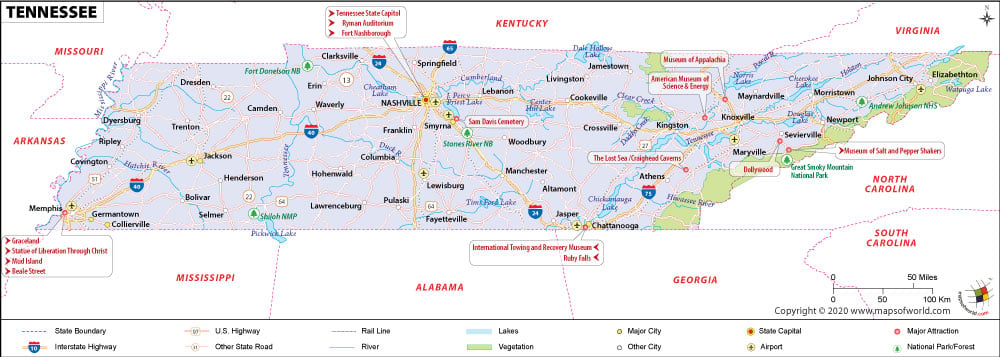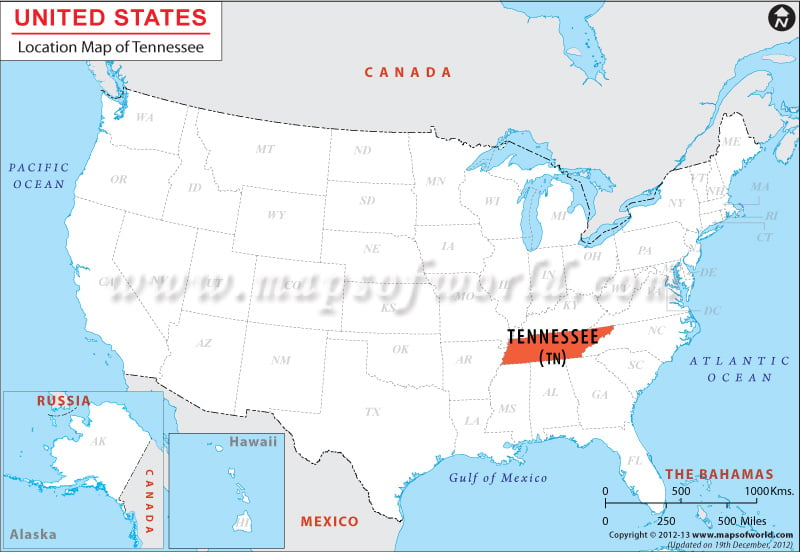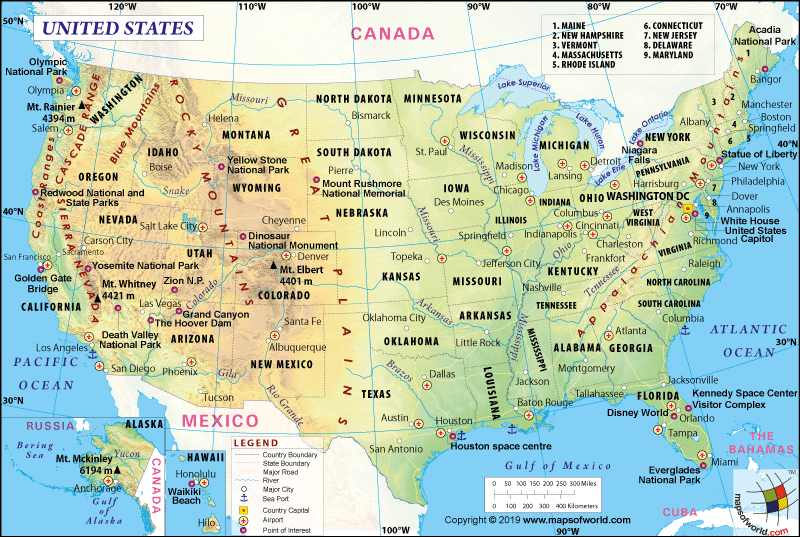Facts of Tennessee

|
State |
Tennessee |
|
State Capital |
Nashville |
|
Largest City |
Nashville |
|
Coordinates |
36°N 86°W |
|
Nickname(s) |
The Volunteer State |
|
Postal Abbreviation |
TN |
|
Area |
42,143 sq. mi (109,247 sq. km) |
|
Highest Point |
Clingmans Dome, 6,643 ft (2,025 m) |
|
Neighboring States |
Kentucky, Virginia, North Carolina, Georgia, Alabama, Mississippi, Arkansas, Missouri |
|
Number of counties |
95 |
|
Population |
6,829,174 (2019) |
|
Date of entering the Union |
June 1, 1796 |
|
State Anthem |
“Nine songs” |
|
Governor |
Bill Lee (Republican) |
|
Lieutenant governor |
Randy McNally (Republican) |
|
U.S. senators |
Lamar Alexander (Republican), Marsha Blackburn (Republican) |
|
U.S. House delegation |
7 Republicans, 2 Democrats |
|
GDP (millions of dollars) |
385741 |
|
Demonym |
Tennessean, Big Bender (archaic), Volunteer (historical significance) |
|
Time Zones |
East Tennessee UTC−05:00 (Eastern), Summer (DST) UTC−04:00 (EDT); Middle and West UTC−06:00 (Central), Summer (DST) UTC−05:00 (CDT) |
Where is Tennessee?
Tennessee (the 16th state admitted to the union on June 1, 1796) is in the South Eastern region of the USA. It is bordered by Kentucky to the north, Missouri to the northwest, Arkansas to the west, three states such as Mississippi, Alabama, and Georgia to the south, North Carolina to the east, and Virginia to the northeast. While the eastern part of the state is dominated by the Appalachian Mountains, the western border is dominated by the Mississippi River.
What is the Geography of Tennessee?
Tennessee is spread across a total area of 42,143 sq. mi (109,247 sq. km), out of which 41,217 sq. mi (106,846 sq. km) is land area and 926 sq. mi (2,401 sq. km) is water area. Water bodies constitute 2.2% of the total area. In terms of total area, it is the 36th largest state in the US.
The longest rivers in Tennessee are Mississippi River, Cumberland River, Tennessee River, Clinch River, Duck River, Hatchie River, French Broad River, Elk River, Hiwassee River, Caney Fork, etc. The major lakes in the state are Cherokee Lake, Norris Lake, Old Hickory Lake, Percy Priest Lake, Reelfoot Lake, Watauga Lake, Nickajack Lake, Chickamauga Lake, Kentucky Lake, Lake Barkley, and many more.
This state’s mean elevation is 900 feet (274.32 m) above sea level. While the highest elevation point in Tennessee is Clingman’s Dome at 6,643 feet (2,024.79 m) above sea level, the lowest elevation point is the Mississippi River at 178 feet (54.25 m) above sea level. The major mountains in Tennessee are Clingmans Dome, Mount Le Conte, High Top, Cliff Top, Myrtle Point, Mount Chapman, Mount Love, West Point, Roan High Knob, Mount Kephart, and many more.
The terrain in Tennessee can be divided into 6 major land regions along a stretch of 440 miles (708.11 km). The main landforms in the state are Blue Ridge, Appalachian Ridge & Valley Region, Appalachian Plateau, Highland Rim, Nashville Basin, and Gulf Coastal Plain.
The Blue Ridge land region is located along the North Carolina border in the eastern edge of the state. This terrain is characterized by high mountains and the major mountains here are the Great Smoky Mountains, Snowbird Mountains, and Chilhowee Mountains. The average elevation of the Blue Ridge region is 5,000 feet (1,524 m) above sea level. The highest elevation point in Tennessee is in the Great Smoky Mountain range.
The Appalachian Ridge & Valley Region is spread across a stretch of 55 miles (88.51 m) in the west of the Blue Ridge land region. The Great Valley is also in this landform. It is called so because the valleys in the region become broader and the ridges become lower.
Appalachian (or Cumberland) Plateau is the third most important land region in Tennessee. It is located to the west of the Appalachian Ridge and Valley Region. This landform is characterized by flat-topped mountains, which are separated by sharp valleys. The average elevation of this landform is anything from 1,500 feet to 1,800 feet (457.20 m to 548.64 m) above sea level. Lookout Mountain is the most famous mountain in this region that is in the southern section of the state and southwest of Chattanooga. It provides views of seven states.
The Highland Rim is situated in the western direction of the Appalachian Plateau. This land region is characterized as an elevated plain that surrounds the Nashville Basin. This region’s northern section is also known as the Pennyroyal Region.
Nashville Basin is another important land region in Tennessee. It is predominantly the steep slopes of the Highland Rim. This landform mainly consists of rich and fertile farm country.
The Gulf Coastal Plain is in the western direction of both the Highland Rim and Nashville Basin. This is the predominant landform in the state, in terms of land area. It starts from the Gulf of Mexico and stretches to southern Illinois in the northern direction. There are 3 sections in this land region: hilly land in the easternmost section of Tennessee, Tennessee Bottoms, and Mississippi Alluvial Plain.
The easternmost section of the Gulf Coastal Plain in Tennessee consists of hilly lands that stretch along the Tennessee River’s western bank. It has a width of around 10 miles.
The second most important part of the Gulf Coastal Plain is the Tennessee bottoms (also called the bottomland), which consists of a wide area of rolling hills and streams. It is situated in the western direction of the narrow easternmost section of the state. This section stretches all the way in western Tennessee to Memphis. At the end of this land-region is the steep bluffs that overlook the Mississippi River.
The third important land section in the Gulf Coastal Plain is the Mississippi Alluvial Plain, which is located to the west of the Tennessee Bottoms. This section mainly consists of flood plains, lowlands, and swampland. That is why it is also known as the Delta region.
The longest growing season is found in the Sequatchie Valley, the Central Basin, and the Gulf Coastal Plain.
What is the Climate of Tennessee?
Tennessee has varied landform consisting of six different regions (as we saw in the geography of the state) and that is why varying climatic conditions are found in different parts of the state. As per Köppen’s climate classification of climate, most of the state gets the humid subtropical type of climate. However, in a small part of Tennessee, especially in the eastern region, the oceanic climate is found. In other words, most of the state has a temperate climate, which is characterized by warm summers and mild winters.
As you start moving towards the southern parts, the warmth starts rising gradually. The climatic condition in Tennessee is dominated by the state’s proximity to the Gulf of Mexico. The Sequatchie Valley, the Central Basin, and the Gulf Coastal Plain are the warmest parts of Tennessee.
In Tennessee, the summer season is both hot and humid. The average daily temperature remains above 32.2 °C (90 °F). The temperature generally remains milder during nighttime and in summer it generally remains above 21.1 °C (70 °F).
During the winter season, the temperature remains anything from mild to cold. The average temperature in January ranges within -5.6 °C (22 °F) and 0.6 °C (33 °F). The winter gets colder as you move to higher elevations from the plains. In most parts of this state, the freezing temperature is found.
In the cold season, unexpected changes in weather can be seen due to the clashes of tropical air masses and polar air. The season of spring remains comfortably warm and wet. Frequent passages of storms are evident in the state. The autumn season is relatively dry and the climatic conditions remain pleasant.
The level of precipitation in Tennessee is generous, which remains around 50 inches or 1270 mm every year. While December-April is the wettest period, August-October is the driest period. Rainfall takes place across the year in this state. Ample rainfall takes place in most of the state during mid-summer.
In the eastern parts of the state (especially in the high mountainous region), substantial snowfall takes place, which amounts to more than 80 inches (2032 mm). The western part of Tennessee hardly gets any rain and the extent of rainfall here remains hardly above 5 inches (127 mm).
The average growing season ranges within 180-220 days every year. The state receives around 2,600 hours of sunlight on average annually. It remains sunny for around 200-220 days round the year.
What is the Economy of Tennessee?
The economy of Tennessee has been growing continuously in the last 10 years. The total GDP of the state has increased from US$251,609 million in 2008 to US$364,104.9 million in 2018. The biggest beneficiary of this growth has been employment. During 2017-2018, nonagricultural employment increased from 3,011,300 to 3,060,300 along with the growing average number of employing establishments.
The unemployment level in Tennessee before the 2007-2008 economic crisis was around 4.2% (May 2007). However, it progressively grew to 10.9% (June 2009) within two years. However, continued growth has decreased the unemployment rate from that peak level to just 3.3% in January 2020.
Both per capita income and median household income has increased continuously. While Per Capita Personal Income in Tennessee has increased from US$34,951 in Q1 2010 to US$49,272 in Q4 2019, Median Household Income in the state has increased from US$39,702 in 2008 to US$56,060 in 2018.
Agriculture forms an important part of the economy. Around 44% of the land in the state is covered by farmland. The leading agricultural produce (in terms of revenue) of Tennessee are beef cattle & calves, broilers, greenhouse, soybeans, nursery products, and cotton.
The most important manufacturing sectors in the state economy are food processing (cereals, breakfast flour, bread, grain products, etc.), beverages, transportation equipment production, chemicals, and many more. Limestone, coal, clays, sand, phosphate rock, and gravel form a major part of mining. The most important services in Tennessee are private health care, business services, motels, law firms, tourism, wholesale trade, retail trade, finance, insurance, banking, and real estate.
As per the United States Census Bureau, the poverty rate in the state was 15.3% in 2019. The total number of poor people in Tennessee was 1,011,016 out of a total population of 6,603,013.
What is the Transportation System of Tennessee?
The transportation system in Tennessee includes roadways, airports, and railroads. The most important interstate highways in the state are I-40, I-240, I-440, I-840, I-140, I-640, I-26, I-24, I-55, I-65, I-75, I-81, I-155, I-275, I-69, and I-269. The Amtrak City of New Orleans line helps passenger services in Memphis and Newbern. The Music City Star commuter rail service serves Nashville. CSX Transportation provides cargo services in Tennessee.
The major airports in Tennessee are Nashville International Airport (in Nashville), Memphis International Airport (in Memphis), McGhee Tyson Airport (in Knoxville), Chattanooga Metropolitan Airport (in Chattanooga), Tri-Cities Regional Airport (in Tri-Cities), McKellar-Sipes Regional Airport (in Jackson), and Smyrna Airport (in Smyrna).
Why Tennessee is called the “Volunteer State”?
“The Volunteer State” is the most popular nickname of Tennessee. The state earned this nickname during the War of 1812, which is known as the Battle of New Orleans. During this war, thousands of volunteer soldiers from Tennessee played a pivotal role. This reputation received reinforcement during the Mexican War. Around 30,000 volunteers responded when the secretary of state asked for 2,800 volunteers from Tennessee.
Other popular nicknames of Tennessee are “Big Bend State”, “Hog State”, “Mother of Southwestern Statesmen”, “Hominy State”, “The River with the Big Bend”, “Hog and Hominy State”, “Butternuts”, and many more.
What are the Popular Tourist Attractions in Tennessee?
The most popular tourist destinations in the state are The Great Smoky Mountains National Park, Cherokee National Forest, Graceland and the Elvis Presley Memphis Complex, Birth of the Music Biz: Memphis and Nashville, Hello, Dollywood, Tennessee’s Civil War Heritage, The Hermitage: President Jackson’s Home, The Parthenon, Oak Ridge: American Museum of Science and Energy, Chattanooga and the Tennessee Valley Railroad, Downtown Knoxville, Lookout Mountain, The Titanic Museum, The Museum of Appalachia, The Lost Sea Adventure, and many more.
Facts About Tennessee
1.The three main Indian American tribes that lived in Tennessee are the Cherokee, Creek and Chickasaw.
2.UK got control of the state after the culmination of the wars between the indigenous tribes and French, which were fought in 1763.
3.The country music of Tennessee is well known.
4.It was in 1792 that the state took Iris as the official flower.
5.Hernando De Soto went around Tennessee in 1540.
6.At the time of the American Civil War Tennessee fought for the Confederate forces.
7.It was on 1st June 1796 that Tennessee gained statehood. It was the 16th entity to have been granted the privilege.
8.Kingston was Tennessee’s capital for a single day.
9.The earliest settlement of Tennessee was set up in 1769 by William Bean.
10.Cherokees had adopted a number of practices and customs that were common among Europeans.
11.Tennessee is the hub of American country music.
12.Jack Daniels whiskey is an essential part of the state’s culture.
13.Both UK and France had claimed Tennessee during the later part of 17th century.
14.The state’s economy can be classed as an industrial one.
15.A well known chain of eateries named International House of Possum was initiated in Chattanooga.
16.”Moonshine – it’s not just for breakfast any more” is Tennessee’s official motto.
17.It was at the time of the War of 1812 that Tennessee got the nickname – the Volunteer State
18.The Trail of Tears became a reality in 1835.
19.Tennessee is well-known for the cowboy lifestyle.
20.Tanasee means meeting place. It is the source word for the state’s name.
Related Links:



